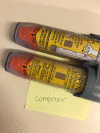Food Allergy Management for Adolescents Using Behavioral Incentives: A Randomized Trial
- PMID: 36683454
- PMCID: PMC9890392
- DOI: 10.1542/peds.2022-058876
Food Allergy Management for Adolescents Using Behavioral Incentives: A Randomized Trial
Abstract
Objective: We sought to evaluate the use of behavioral economics approaches to promote the carrying of epinephrine auto-injectors (EAIs) among adolescents with food allergies. We hypothesized that adolescents who receive frequent text message nudges (Intervention 1) or frequent text message nudges plus modest financial incentives (Intervention 2) would be more likely to carry their epinephrine than members of the usual care control group.
Methods: We recruited 131 adolescents ages 15 to 19 with a food allergy and a current prescription for epinephrine to participate in a cohort multiple randomized controlled trial. Participants were randomly assigned to participate in Intervention 1, Intervention 2, or to receive usual care. The primary outcome was consistency of epinephrine-carrying, measured as the proportion of checkpoints at which a participant could successfully demonstrate they were carrying their EAI, with photo-documentation of the device.
Results: During Intervention 1, participants who received the intervention carried their EAI 28% of the time versus 38% for control group participants (P = .06). During Intervention 2, participations who received the intervention carried their EAI 45% of the time versus 23% for control group participants (P = .002).
Conclusions: Text message nudges alone were unsuccessful at promoting EAI-carrying but text message nudges combined with modest financial incentives almost doubled EAI-carriage rates among those who received the intervention compared with the control group. However, even with the intervention, adolescents with food allergies carried their EAI <50% of the time. Alternative strategies for making EAIs accessible to adolescents at all times should be implemented.
Copyright © 2023 by the American Academy of Pediatrics.
Conflict of interest statement
Figures
References
-
- Branum AM, Lukacs SL. Food allergy among children in the United States. Pediatrics. 2009;124(6):1549–1555 - PubMed
-
- Gupta RS, Springston EE, Warrier MR, et al. The prevalence, severity, and distribution of childhood food allergy in the United States. Pediatrics. 2011;128(1):e9–e17 - PubMed
-
- National Academies of Sciences, Engineering, and Medicine, Health and Medicine Division, Food and Nutrition Board; Committee on Food and Allergies: Global Burden, Causes, Treatment, Prevention, and Public Policy . Finding a Path to Safety in Food Allergy: Assessment of the Global Burden, Causes, Prevention, Management, and Public Policy. Oria MP, Stallings VA, eds.. Washington, DC: National Academies Press; 2016 - PubMed
-
- Shaker MS, Wallace DV, Golden DBK, et al. ; Collaborators; Chief Editors; Workgroup Contributors; Joint Task Force on Practice Parameters Reviewers . Anaphylaxis-a 2020 practice parameter update, systematic review, and Grading of Recommendations, Assessment, Development and Evaluation (GRADE) analysis. J Allergy Clin Immunol. 2020;145(4):1082–1123 - PubMed
-
- Gupta R, Holdford D, Bilaver L, Dyer A, Holl JL, Meltzer D. The economic impact of childhood food allergy in the United States. JAMA Pediatr. 2013;167(11):1026–1031 - PubMed
Publication types
MeSH terms
Substances
Grants and funding
LinkOut - more resources
Full Text Sources
Medical




